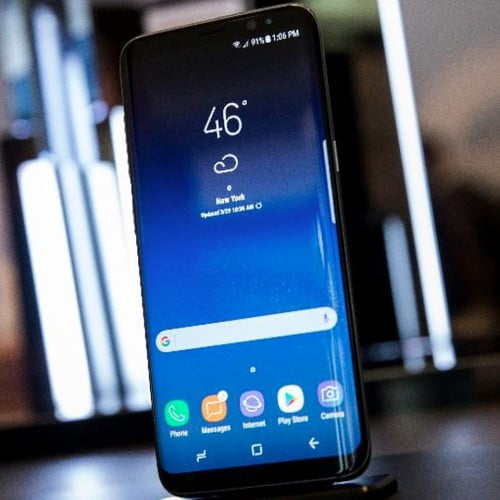 Taking a look back at seven days of news and headlines across the world of Android, this week’s Android Circuit includes issues with the Galaxy S8 Screen, a review of the S8 camera, how Google’s Pixel 2 can defeat Samsung’s Galaxy, the ridiculously small Jelly smartphone, the latest updates for the OnePlus 3 family, Google helping Gmail users with spam, Android betas for all, and using Microsoft on your Android smartphone.
Taking a look back at seven days of news and headlines across the world of Android, this week’s Android Circuit includes issues with the Galaxy S8 Screen, a review of the S8 camera, how Google’s Pixel 2 can defeat Samsung’s Galaxy, the ridiculously small Jelly smartphone, the latest updates for the OnePlus 3 family, Google helping Gmail users with spam, Android betas for all, and using Microsoft on your Android smartphone.
Android Circuit is here to remind you of a few of the many things that have happened around Android in the last week (and you can find the weekly Apple news digest here).
Saving The Screen
Could the Galaxy S8’s OLED screen suffer from ‘burn-in’? That’s the prospect raised earlier this week in reports from South Korean, but Samsung has already taken steps to reduce the software-based home key’s impact on the pixels:
What should be noted is that OLED burn-in is a recognized concept and the South Korean company will have experience of this issue via their TV and monitor display business. Corrective action is already in software, and if you are one of the inquisitive users who has spotted the home key button moving around your screen, then you’ll have seen this in action.
The technique to avoid OLED screen-burn shows a company that has been looking at potential issues and working around them.
More on Samsung’s preventative approach here on Forbes.

The Galaxy S8 Camera Meets The Competition
Ben Sin has been reviewing two of the leading Android handsets – the aforementioned Samsung Galaxy S8 and the LG G6. When you have both handsets at your disposal, there’s only one thing to do that is right and proper… put them into a head-to-head challenge over multiple parts, starting with the cameras.
I have been using both the Galaxy S8 and a G6 lately so I figured why not do a series of head-to-head tests. This first post will be a camera shootout between the two phones. Then I’ll probably do a second post on software usability, and finally, I’ll do a drop test video and see which phone is more durable.
The Galaxy S8 has a single 12-megapixel f/1.7 shooter while the G6 has a main 13-megapixel f1/8 camera with a secondary wide-angle lens. Since the S8 is missing the second lens, I’ll just focus on shooting with the main camera, in point-and-shoot situations in automatic mode. Of course, the G6 shouldn’t be penalized for having a second camera that can do more tricks, so I’ll address that at the very end.
Sin continues the shoot-out online.
How The Pixel 2 Can Take On The Galaxy
What does Google’s next smartphone have to do to ‘defeat’ the Galaxy S8 and claim the title of best Android smartphone? CNet’s Lynn La sits down to consider what the Pixel 2 needs to take on the South Korean champion, including the battery, the camera, and the physical design:
I was already fond of the Pixel’s elegant design, and I’m not one to hop on every phone trend that comes through the pipeline. But people have always been infatuated with bezelless phones long before this year, and now that the S8 and G6 have thin bezels, the new Pixel risks looking dated if it doesn’t follow suit. I’m not saying that barely there bezels are a must-have, and if Google flipped the script in phone design in another welcome way, I’d be all for it. But thin bezels will help usher the handset into today’s sleek tech aesthetic.
Watching Smartphones Getting Smaller
The trend for smaller smartphones is one that is well-known in the industry, but Unihertz’s Jelly pushes the limits. The 4G smartphone comes with 2GB of RAM, 16 GB of storage, a 2.45 inch screen, but in a 60g package that is just over 92mm in size. There’s more on the phone at Kickstarter, but of course be aware that it is a crowd-sourced project which carries some risk. Unbox Therapy introduces the phone:
More Updates For The One Plus 3 Family
Owners of the OnePlus 3 and OnePlus 3T using the beta operating software have seen a consistent run of updates for the Shenzhen-manufactured handset. This week saw Beta 15 (One Plus 3) and Beta 6 (3T) picks up changes to the UI and improvements to the action bar in the communication apps. Ben Schoon reports:
…[This] isn’t a major system update, but rather a minor one to refresh the UI a bit in areas such as the dialer, messages app, settings, and contacts. The company has also introduced a new “action bar” to the messages and settings apps. The update also brings along some optimizations for Bluetooth as well as the phone’s Night Mode setting.
More at 9to5Google.

Ewan Spence
OnePlus 3T (image: Ewan Spence)
Helping With Spam
As fraudsters and phisers become more advanced with their methods, spotting false link and security issues is becoming harder. To help consumers, Google has announced a new feature in Android’s Gmail app that will flag up suspicious looking links when you tap on them to give you a chance to consider your actions and hopefully make your email a little bit safer:
This week, we’re introducing a new security feature in Gmail on Android to help you keep your email safer. When you click on a suspicious link in a message, Gmail will show a warning prompt helping you keep your account safe.
While not all affected email will necessarily be dangerous, we encourage you to be extra careful about clicking on links in messages that you’re not sure about. And with this update, you’ll have another tool to make these kinds of decisions.
More details at the G Suite Blog.
Android Betas For All
Although developers have had access to the early versions of Android O, the general public have been kept at arms length from the work-in-progress early versions. Google is now preparing to open up the Beta program to any interested Nexus and Pixel owners. Justin Duino reports:
For the last two Android releases, Google’s beta program has allowed Nexus and then Pixel users to test out upcoming features and builds before anyone else. Although these builds were typically buggy, it didn’t stop hardware fans from running it on their main devices. Now that Android O’s developer preview has been available for a few months, we’ve been waiting for Google to update its public beta program for the upcoming version of Android, and it appears to be happening soon.
More at 9to5Google.

Android N Devices (image: Google.com)
And Finally…
Could you live with an Android phone without using Google’s services? Could you replace them with Microsoft’s services? Would it be a better phone? Zak Bowden decided to find out:
…Now that we’ve disabled all of Google’s out of box apps and installed Microsoft’s own launcher and lock screen, it’s time to start replacing them with Microsoft’s own apps. To see a list of Microsoft apps available on Android, I simply headed to the Play Store and searched “Microsoft” in the search tab which will bring up an incredibly long list of Microsoft apps available on the platform.
It becomes obvious very quickly that Microsoft is all in on Android, with literally hundreds of apps available from the software maker. So first and foremost, I went ahead and downloaded the Outlook app, so I could get my Mail and Calendar setup on my phone.
More at Windows Central.
Android Circuit rounds up the news from the Android world every weekend here on Forbes. Don’t forget to follow me so you don’t miss any coverage in the future, and of course read the sister column in Apple Loop! Last week’s Android Circuit can be found here, and if you have any news and links you’d like to see featured in Android Circuit, get in touch!
Follow me on Facebook. Find more of my work at ewanspence.co.uk, on Twitter, and Linked In. You should subscribe to my weekly newsletter of ‘Trivial Posts’.
[“Source-forbes”]




